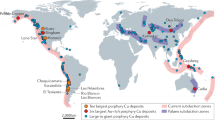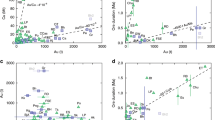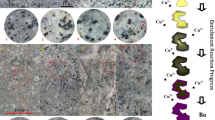Abstract
Porphyry copper deposits provide around 75%, 50% and 20% of world copper, molybdenum and gold, respectively1. The deposits are mainly centred on calc-alkaline porphyry magmatic systems2,3 in subduction zone settings1. Although calc-alkaline magmas are relatively common, large porphyry copper deposits are extremely rare and increasingly difficult to discover. Here, we compile existing geochemical data for magmatic plagioclase, a dominant mineral in calc-alkaline rocks, from fertile (porphyry-associated) and barren magmatic systems worldwide, barren examples having no associated porphyry deposit. We show that plagioclase from fertile systems is distinct in containing ‘excess’ aluminium. This signature is clearly demonstrated in a case study carried out on plagioclase from the fertile La Paloma and Los Sulfatos copper porphyry systems in Chile. Further, the presence of concentric zones of high excess aluminium suggests its incorporation as a result of magmatic processes. As excess aluminium has been linked to high melt water contents, the concentric zones may record injections of hydrous fluid or fluid-rich melts into the sub-porphyry magma chamber. We propose that excess aluminium may exclude copper from plagioclase, so enriching the remaining melts. Furthermore, this chemical signature can be used as an exploration indicator for copper porphyry deposits.
This is a preview of subscription content, access via your institution
Access options
Subscribe to this journal
Receive 12 print issues and online access
$259.00 per year
only $21.58 per issue
Buy this article
- Purchase on Springer Link
- Instant access to full article PDF
Prices may be subject to local taxes which are calculated during checkout



Similar content being viewed by others
References
Sillitoe, R. H. Porphyry copper systems. Econ. Geol. 105, 3–41 (2010).
Richards, J. P. High Sr/Y arc magmas and porphyry Cu ± Mo ± Au deposits: just add water. Econ. Geol. 106, 1075–1081 (2011).
Loucks, R. R. Distinctive composition of copper-ore-forming arc magmas. Aust. J. Earth. Sci. 61, 5–16 (2014).
Grove, T. L., Baker, M. B. & Kinzler, R. J. Coupled CaAl–NaSi diffusion in plagioclase feldspar: experiments and applications to cooling rate speedometry. Geochim. Cosmochim. Acta 48, 2113–2121 (1984).
Blundy, J. D. & Shimizu, N. Trace element evidence for plagioclase recycling in calc-alkaline magmas. Earth Planet. Sci. Lett. 102, 178–197 (1991).
Irarrazaval, V. et al. in The Challenge of Finding New Mineral Resources: Global Metallogeny, Innovative Exploration, and New Discoveries (eds Goldfarb, R. J., Marsh, E. E. & Monecke, T.) Vol. 15 253–269 (Society of Economic Geologists, 2010).
Kyono, A. & Kimata, M. Refinement of the crystal structure of a synthetic non-stoichiometric Rb-feldspar. Mineral. Mag. 65, 523–531 (2001).
Kimata, M. et al. Anorthite megacrysts from island arc basalts. Mineral. Mag. 59, 1–14 (1995).
Cannell, J. El Teniente Porphyry Copper Molybdenum Deposit, Central Chile PhD thesis, Univ. Tasmania (2004).
Vry, V. H., Wilkinson, J. J., Seguel, J. & Millán, J. Multistage intrusion, brecciation, and veining at El Teniente, Chile: evolution of a nested porphyry system. Econ. Geol. 105, 119–153 (2010).
Sisson, T. W. & Grove, T. L. Experimental investigations of the role of H2O in calc-alkaline differentiation and subduction zone magmatism. Contrib. Mineral. Petrol. 113, 143–166 (1993).
Ewart, A. & Griffin, W. L. Application of proton-microprobe data to trace-element partitioning in volcanic rocks. Chem. Geol. 117, 251–284 (1994).
Chiaradia, M. Copper enrichment in arc magmas controlled by overriding plate thickness. Nature Geosci. 7, 43–46 (2014).
Richards, J. P. The oxidation state, and sulfur and Cu contents of arc magmas: implications for metallogeny. Lithos 233, 27–45 (2015).
Dilles, J. H. Petrology of the Yerington Batholith, Nevada: evidence for evolution of porphyry copper ore fluids. Econ. Geol. 82, 1750–1789 (1987).
Ewart, A., Bryan, W. B. & Gill, J. B. Mineralogy and geochemistry of the Younger Volcanic Islands of Tonga, S. W. Pacific. J. Petrol. 14, 429–465 (1973).
Renner, L. C., Hartmann, L. A., Wildner, W., Massonne, H.-J. & Theye, T. A micro-analytical approach to partition coefficients in plagioclase and clinopyroxene of basaltic sills in Serra Geral Formation, Paraná Basin, Brazil. Rev. Bras. Geocienc. 41, 263–289 (2011).
Wilkinson, J. J. Triggers for the formation of porphyry ore deposits in magmatic arcs. Nature Geosci. 6, 917–925 (2013).
Zellmer, G. F., Sparks, R. S. J., Hawkesworth, C. J. & Wiedenbeck, M. Magma emplacement and remobilization timescales beneath Montserrat: insights from Sr and Ba zonation in plagioclase phenocrysts. J. Petrol. 44, 1413–1431 (2003).
Richards, J. P. Magmatic to hydrothermal metal fluxes in convergent and collided margins. Ore Geol. Rev. 40, 1–26 (2011).
Piquer, J., Skarmeta, J. & Cooke, D. R. Structural evolution of the Rio Blanco-Los Bronces District, Andes of Central Chile: controls on stratigraphy, magmatism and mineralization. Econ. Geol. 110, 1995–2023 (2015).
Stewart, D. B., Walker, G. W., Wright, T. L. & Fahey, J. J. Physical properties of calcic labradorite from Lake County, Oregon. Am. Mineral. 51, 177–197 (1966).
Straub, S. M. in Dynamics of Crustal Magma Transfer, Storage and Differentiation (eds Annen, C. & Zellmer, G. F.) 261–283 (Special Publication 304, Geological Society of London, 2008).
Acknowledgements
The project would not have been possible without the financial and logistical support of Anglo American, including former and current staff: J. Coppard, V. Irarrazaval, M. Buchanan, E. Liebmann, R. Mattos Pino, E. Centino, J. Andronico, R. Mauricio, D. Fernando and J. Zamorano. J. Spratt (Natural History Museum, London) and S. Pendray (University of Exeter) are thanked for EPMA support and thin section preparation, respectively. K. Cashman (Bristol University), S. Hesselbo, J. Pickles and S. Broom-Fendley (University of Exeter), and reviewer J. Richards (University of Alberta), are gratefully acknowledged for comments on the manuscript.
Author information
Authors and Affiliations
Contributions
B.J.W. and R.J.H. wrote the manuscript. A.M. carried out the LA-ICP-MS analyses of the plagioclase at the LODE Facility, Natural History Museum (NHM), London.
Corresponding author
Ethics declarations
Competing interests
The authors declare no competing financial interests.
Supplementary information
Supplementary Information
Supplementary Information (PDF 849 kb)
Supplementary Information
Supplementary Information (XLSX 63 kb)
Rights and permissions
About this article
Cite this article
Williamson, B., Herrington, R. & Morris, A. Porphyry copper enrichment linked to excess aluminium in plagioclase. Nature Geosci 9, 237–241 (2016). https://doi.org/10.1038/ngeo2651
Received:
Accepted:
Published:
Issue Date:
DOI: https://doi.org/10.1038/ngeo2651
This article is cited by
-
Crucial Geochemical Signal Identification for Cu-Fertile Magmas in Paleo-Tethyan Arc Based on Machine Learning
Mathematical Geosciences (2023)
-
Genesis and metallogenic characteristic of Dongnan Cu–Mo deposit associated granitoids: LA-ICP-MS zircon U–Pb dating and isotope constraint from Zijinshan ore field in southeastern China
Acta Geochimica (2023)
-
A rapid change in magma plumbing taps porphyry copper deposit-forming magmas
Scientific Reports (2022)
-
Machine Learning and Singularity Analysis Reveal Zircon Fertility and Magmatic Intensity: Implications for Porphyry Copper Potential
Natural Resources Research (2022)
-
Gardaneh Salavat porphyry copper system: Is it about metal endowment or fertility of the porphyritic intrusion?
Acta Geochimica (2022)



